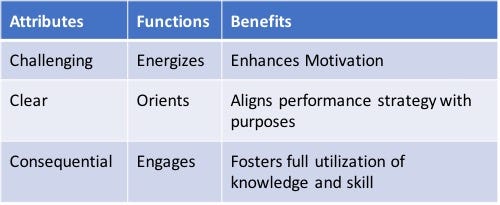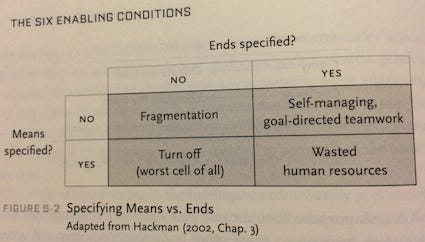Setting the team’s purpose for a self organizing team can feel counter intuitive. In a way you want to set the purpose of the team on the other hand you don’t want to be too directive. In this story I will explain why this even required with highly professional teams. Simply stating “You know what to do is not enough” (1).
Purpose on individual and team level
On individual and team level setting the right purpose will help creating more focus and prevent wasting energy on topics or discussions not relevant. In a very interesting study on how top performers operate Morton Hanson found out top performers focus on few key areas and then obsess to excel in it(2).
The same applies for team level. As a team member you must be able to know whether your decisions and others’ are helping the team get closer to its goal or not. You must be able to know when to say no, you must be able to know how well you are doing individually and as a group. And, this can only be achieved by a clear purpose. A clear and compelling purpose enables alignment and therefore autonomy.
The definition of team purpose belongs to the team itself, it’s part of its identity. We cannot call a group of people a “team” without a shared, clear and compelling purpose about which they hold each other accountable for (3).
Attributes of a good team Purpose
A team’s purpose cannot be too vague so that members have to make assumptions about what the leader is most interested in nor too clear, specific and boring. Establishing a good team purpose involves finding a way to frame and communicate the work that both points the team in the right direction and fully engages its members.

Clarity orients the team, challenge energizes the team and consequential engages member’s talents.
Ends vs Means
The best statements of team purpose are those that clearly specify the endsa team is to achieve but that leave it to the team to decide about the meansit uses in pursuing those ends.

A clear purpose is key to self-organization. Specifying the ends, but no the means, builds on trust and human motivation.
How to create a good team purpose?
In this story I give 3 recommadations to define a team purpose
Gerard Chiva (3) described the following questions to define a good purpose:
Vision / Goal (WHAT):
What is your goal as a team for next 6 months?
Purpose / Motivation (WHY):
What will be different/better when you achieve that?
How achieving this objective is going to make your customers’/organizations’ better?
Success Measures:
How would you know you are there?
How would you be able to say you achieved your goal?
What will you see when you get there?
What will people say when you get there?
Progress Measures:
How will you know you are in the right direction?
A second options is to use a Liberating Structure called Purpose-To-Practice (P2P) (4).
The third option is to use the team canvas (5)
In the next article I will focus on Team enabling condition 3: are the right people on board?
(1) Collaborative Intelligence — Using Teams to Solve Hard Problems, J. Richard Hackman, 2011.
(2) Great at work ,How Top Performers Do Less, Work Better, and Achieve More, Morten Hansen, 2018.
(3) Compelling Team Purpose, Gerard Chiva, 2015
(4) http://www.liberatingstructures.com/33-purpose-to-practice-p2p/
(5) Team Canvas : http://theteamcanvas.com/about/

Hi Ronald, insigthfull article about why a team purpose is important and which steps to take to make a purpose. You could even make the article better (for me) to have examples of every step. For me examples speaks louder than thousand words 🙂
Thanks for the article. I’m going to use the steps you have described in my new team.
Kind regards,
Wouter